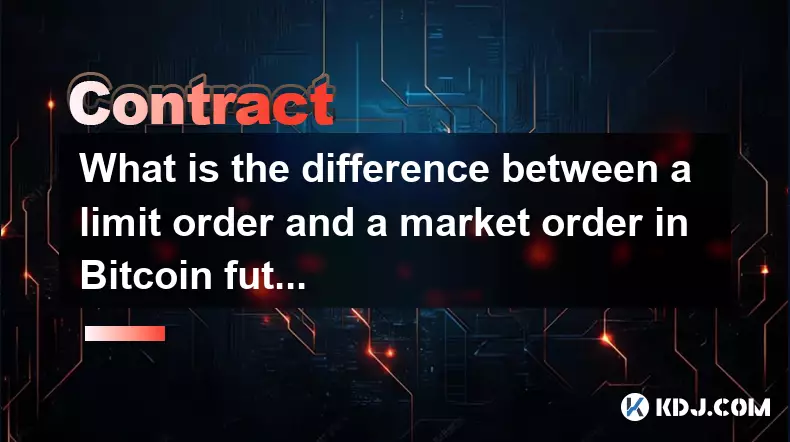-
 bitcoin
bitcoin $109523.663807 USD
-0.13% -
 ethereum
ethereum $4019.526508 USD
2.06% -
 tether
tether $1.000482 USD
0.00% -
 xrp
xrp $2.776815 USD
0.18% -
 bnb
bnb $958.942396 USD
0.12% -
 solana
solana $204.294698 USD
3.84% -
 usd-coin
usd-coin $0.999693 USD
0.00% -
 dogecoin
dogecoin $0.232115 USD
2.09% -
 tron
tron $0.338028 USD
0.84% -
 cardano
cardano $0.790920 USD
1.50% -
 hyperliquid
hyperliquid $44.871443 USD
5.60% -
 ethena-usde
ethena-usde $1.000322 USD
0.04% -
 chainlink
chainlink $21.034165 USD
2.60% -
 avalanche
avalanche $28.794831 USD
-0.54% -
 stellar
stellar $0.360466 USD
1.24%
What is the difference between a limit order and a market order in Bitcoin futures?
Market orders execute instantly at the best available price, prioritizing speed over precision, while limit orders offer price control but no execution guarantee.
Sep 24, 2025 at 08:54 am

Understanding Market Orders in Bitcoin Futures
1. A market order is executed immediately at the best available price in the market. When traders place a market order, they prioritize speed over price precision. This type of order guarantees execution but not the price at which it will be filled.
2. In fast-moving markets such as Bitcoin futures, slippage can occur with market orders. If liquidity is low or volatility is high, the final execution price may differ significantly from the last traded price. This risk increases during major news events or macroeconomic announcements.
3. Market orders are commonly used when entering or exiting positions quickly. Traders who believe price movement is imminent and want immediate exposure often rely on market orders to avoid missing opportunities.
4. Due to their nature, market orders remove the need for constant monitoring. Once submitted, the trade executes without requiring further input, making them suitable for automated trading strategies or urgent position adjustments.
The Role of Limit Orders in Bitcoin Futures Trading
1. A limit order allows traders to specify the exact price at which they are willing to buy or sell Bitcoin futures. The trade will only execute if the market reaches that predefined price, offering greater control over entry and exit points.
2. While limit orders provide price certainty, they do not guarantee execution. If the market never reaches the specified price, the order remains unfilled, potentially causing traders to miss desired trading levels.
3. These orders are especially useful in range-bound or predictable markets where traders anticipate specific support or resistance levels. By placing limit orders near these technical zones, traders aim to optimize their risk-reward ratios.
4. Limit orders contribute to market depth by adding resting bids and asks on order books. High concentrations of limit orders at certain price levels often signal strong market interest and can influence future price action.
Key Differences Between Limit and Market Orders
1. Execution speed differs significantly between the two types. Market orders execute instantly, while limit orders wait for price alignment and may never fill.
2. Price control is a defining factor. With a limit order, the trader sets the price; with a market order, the market determines the price. This distinction becomes critical during periods of high volatility when sudden price swings can lead to unfavorable fills.
3. Slippage affects market orders more than limit orders. In illiquid futures contracts or during flash crashes, market orders can result in substantial deviations from expected prices. Limit orders inherently protect against negative slippage by capping acceptable execution levels.
4. Order book impact varies. Limit orders add liquidity to the market and may qualify for maker fee rebates on many exchanges. Market orders remove liquidity and typically incur taker fees, increasing trading costs over time.
Strategic Use Cases in Volatile Conditions
1. During sharp rallies or sell-offs in Bitcoin futures, market orders enable rapid response. Traders reacting to breaking news or technical breakdowns may accept uncertain pricing to secure position changes before conditions worsen.
2. In consolidating markets, limit orders allow precise placement just above resistance or below support. This strategy helps traders capture reversals without chasing price, enhancing profitability through disciplined entries.
3. Scalpers frequently combine both order types. They might use limit orders to enter positions at favorable spreads and market orders to exit swiftly when small profit targets are reached.
4. Stop-limit and stop-market configurations build upon these fundamentals. For instance, a stop-market order triggers a market order once a threshold is hit, ensuring exit during extreme moves, while a stop-limit offers more control but risks non-execution.
Frequently Asked Questions
Can a limit order become a market order?No, a limit order cannot transform into a market order. However, some platforms offer advanced order types like 'immediate-or-cancel' or 'fill-or-kill' that combine aspects of both, but the core mechanics remain distinct.
Why would someone choose a market order despite slippage risk?Traders opt for market orders when immediacy is essential. Missing a move due to a pending limit order can result in greater opportunity cost than the slippage incurred by a market execution.
Do all exchanges treat limit and market orders the same way?While the basic definitions are consistent, execution quality varies across exchanges based on liquidity, matching engine speed, and order book depth. Premium platforms often provide better fill rates for both order types.
How does leverage affect market and limit orders in Bitcoin futures?Leverage amplifies both gains and losses but does not alter how orders are executed. However, highly leveraged positions increase the risk of liquidation, making order type selection even more crucial for risk management.
Disclaimer:info@kdj.com
The information provided is not trading advice. kdj.com does not assume any responsibility for any investments made based on the information provided in this article. Cryptocurrencies are highly volatile and it is highly recommended that you invest with caution after thorough research!
If you believe that the content used on this website infringes your copyright, please contact us immediately (info@kdj.com) and we will delete it promptly.
- Bitwise, Solana, and the ETF Filing Frenzy: What's the Deal?
- 2025-09-28 06:25:16
- Ruvi AI: Surpassing Tron's Demand, the Next 100x Token?
- 2025-09-28 06:25:16
- BSE, IPOs, and Crypto Funds: A New York Minute on India's Regulatory Tightrope
- 2025-09-28 06:30:01
- Ruvi AI: The Avalanche Ecosystem's Next Big Thing, Blazing Through Phase 3
- 2025-09-28 06:30:01
- Tron, Ruvi AI, and Institutional Backing: What's the Buzz?
- 2025-09-28 06:30:01
- Q-UP: Is Coin Flipping the Next eSports Sensation? A Look at Fairness in Gaming
- 2025-09-28 06:30:15
Related knowledge

How do I enable the "scalping-only" mode for Cardano (ADA) contracts?
Sep 24,2025 at 03:19am
Understanding Scalping Strategies in Crypto Derivatives1. Scalping in cryptocurrency trading refers to executing multiple short-term trades within min...

What is the settlement time for Cardano (ADA) contracts?
Sep 28,2025 at 04:18am
Understanding Cardano's Contract Settlement Mechanism1. Cardano operates on a proof-of-stake consensus model known as Ouroboros, which fundamentally i...

How do I add margin to Cardano (ADA) contracts?
Sep 27,2025 at 07:54pm
Understanding Margin in Cardano (ADA) Smart ContractsCardano operates on a proof-of-stake blockchain that supports smart contracts through its Plutus ...

What is the maximum position limit for Cardano (ADA) contracts?
Sep 23,2025 at 11:00pm
Understanding ADA Futures and Derivatives Market Structure1. Cardano (ADA) futures contracts are offered by several major cryptocurrency derivatives e...

What is the maker fee for Cardano (ADA) contracts?
Sep 26,2025 at 09:01am
Understanding Maker Fees in Cardano (ADA) Contracts1. The concept of maker fees applies broadly across decentralized exchanges and smart contract plat...

How can I view open interest in Cardano (ADA) contracts?
Sep 24,2025 at 07:36am
Understanding Open Interest in Cardano Derivatives1. Open interest refers to the total number of outstanding derivative contracts, such as futures or ...

How do I enable the "scalping-only" mode for Cardano (ADA) contracts?
Sep 24,2025 at 03:19am
Understanding Scalping Strategies in Crypto Derivatives1. Scalping in cryptocurrency trading refers to executing multiple short-term trades within min...

What is the settlement time for Cardano (ADA) contracts?
Sep 28,2025 at 04:18am
Understanding Cardano's Contract Settlement Mechanism1. Cardano operates on a proof-of-stake consensus model known as Ouroboros, which fundamentally i...

How do I add margin to Cardano (ADA) contracts?
Sep 27,2025 at 07:54pm
Understanding Margin in Cardano (ADA) Smart ContractsCardano operates on a proof-of-stake blockchain that supports smart contracts through its Plutus ...

What is the maximum position limit for Cardano (ADA) contracts?
Sep 23,2025 at 11:00pm
Understanding ADA Futures and Derivatives Market Structure1. Cardano (ADA) futures contracts are offered by several major cryptocurrency derivatives e...

What is the maker fee for Cardano (ADA) contracts?
Sep 26,2025 at 09:01am
Understanding Maker Fees in Cardano (ADA) Contracts1. The concept of maker fees applies broadly across decentralized exchanges and smart contract plat...

How can I view open interest in Cardano (ADA) contracts?
Sep 24,2025 at 07:36am
Understanding Open Interest in Cardano Derivatives1. Open interest refers to the total number of outstanding derivative contracts, such as futures or ...
See all articles










































































